As well as Finnish Volunteers in Estonia helping the Estonians gain their independence, there was a sizable contingent of Danish Volunteers in Estonia who fought in the Estonian War of Independence. These Danish Volunteers in Estonia were led by Captain Richard Gustav Borgelin (10 February 1887, Herning, Denmark – 8 December 1966, Copenhagen, Denmark).
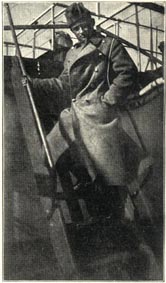
Captain Borgelin boarding the S/S “Väinämöinen”,
Helsingfors 3 April 1919
Borgelin was a Danish officer and company commander of the Danish-Baltic Auxiliary Corps (DBAC) in 1919 during the Estonian and Latvian War of Independence. Borgelin attended and successfully completed his education at the Royal Danish Army Officers Academy in 1909. In 1919, when Borgelin was an officer of the reserve and in charge of the Second Regiment Corporal School at the Værløse Camp in northern Zealand, he was offered the post of company commander of a combat unit consisting of 200 men which would fight in the Baltic States against the Bolsheviks.
In early March 1919 the Finnish steamer S/S Merku of Helsinki arrived in Copenhagen. The steamship, commanded by Captain Ilmari A. Jokinen had been chartered by the Estonian government to transport the first contingent of the Danish-Baltic Auxiliary Corps (DBAC) to Finland. The Merkur could not depart until 260 berths had been set up for the men, equipment loaded and catering for the Danish Corps prepared for. While the S/S Merkur was being prepared, the enlisted soldiers began to gather in Copenhagen. There was some turmoil between Copenhagen syndicalists – socialists who fiercely fought against the dispatch of the Danish Aid Corps – and uniformed members of the corps.
The crews of the harbor tugs were in sympathy with the syndicalists and announced that they would not tow S/S Mercury out of the harbor, the soldiers disembarked from the S/S Merkur on 22 March, after which the steamer sailed under the guise of shipping “food” to Finland. Captain Jokinen then reversed the engines and cast anchor in the outer harbor off the Langelinie. Here Corps personnel boarded over the next few days using skiffs. On the morning of 26 March the S/S Merkur departed from Copenhagen with approximately 200 members of the DBAC. Some enlisted soldiers did not manage to get on board – or had lost courage and had jumped ship at the last moment.
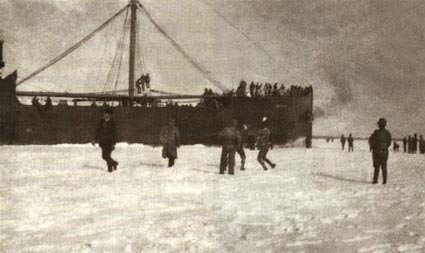
S/S Merkur in Hangö, 30 March 1919
On board the steamer was also the Finnish Major-General Leonard Torsten Lode (1855-1924, Military Attache in Denmark – Lode had been in the Tsarist Russian Army, fought in the war against Turky in 1877, retired from the Russian Army with the rank of Colonel in 1904 and had worked as a businessman in Sweden and Denmark from 1904 to 1918. He served in the Finnish White Army as a Major-General in the Civil War but had returned to Denmark as the Military Attache afterwards) who signed all contracts on behalf of the Estonian government. In international waters, well out in the Sound, they could sign the contracts between the volunteer soldiers and the Government of Estonia without breaking Danish law. When all contracts were signed, General Lode left the ship and returned to land on the Swedish pilot boat Trelleborg.
On Friday 28 March from aboard the S/S Merkur and in the middle of the Baltic Sea, a message was sent to the head of the Corps, Col. Gudme, advising that the Rifle company under Captain Richard Borgelin and a field battery under Captain J M Mortensen were en-route. Highlights of the S/S Merkur’s 6 day long voyage to Finland included passing through the Åland Islands, where the ship ran aground – a steamboat came to assist, however the Merkur freed itself under its own power.
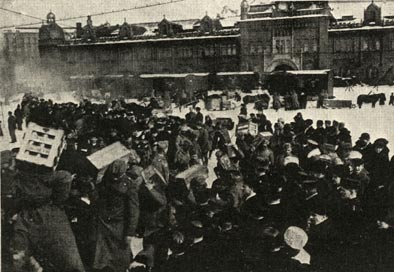
Helsinki. Danish volunteers transferring supplies from rail wagons to the Icebreaker
The rest of the journey was in a slow convoy sailing with the assistance of the icebreaker “Tarmo” through the archipelago to the port of Hanko – with S/S Merkur and the corps arriving on 31 March 1919. Here, the crew and the corps extensive supplies of blah. Danish food and equipment was reloaded onto rail cars before the men disembarked for a train journey through Southern Finland to Helsinki. The Corps made a short stay in Helsinki, and again were all the supplies were offloaded and onloaded again- this time from railway wagons onto the Finnish icebreaker Väinämöinen – which would carry the corps through across the Gulf of Finland to the Estonian capital of Tallinn. During the short stay in Helsinki, Captain Borgelin, CO of the DBAC’s first Company, paid a visit on the Regent of Finland, General Mannerheim. At 10:00am on the morning of 3 April 1919, the men of the DBAC went aboard the icebreaker Väinämöinen for the short voyage from Helsinki to Tallinn – a crossing which usually lasted about 3 hours. However, the severe winter in the Gulf of Finland was at its peak and the icebreaker had to fight its way through the ice for 11 hours before the Danish corps could set foot on Estonian soil.
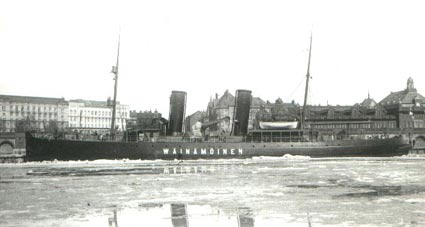
The Finnish Icebreaker Väinämöinen transported men of the DBAC from Helsingfors to Tallinn – 3 April 1919
Although several sources state 3 April 1919 as the day of DBAC’s arrival in Estonia, may be taken in the following days have happened further transport of personnel and equipment from Helsinki to Tallinn. A postcard from one of the Danish volunteers dated in Helsinki on 12 April, mentions an impending icebreaker voyage to Estonia. Ice began to break up in the Gulf of Finland around the 20th April – after which voyages between Estonia and Finland could proceed without icebreaker assistance.
In the spring of 1919, Borgelin and his Compagnie Borgelin arrived in Estonia from Denmark via Finland with 12 Danish officers, 12 Danish junior officers and 189 Danish privates. When the Danish Baltic Auxiliary Corps arrived in Tallinn the unit was also formally dissolved, and from then on, the Danish force was referred to as a Rekylkompagni “Compagnie Borgelin” associated with the Estonian army. On arrival in Estonia, the Danish Volunteers were initially accommodated in the capital Tallinn (Reval) – the men in the Libau barracks and the officers at the Hotel Goldener Lowe.
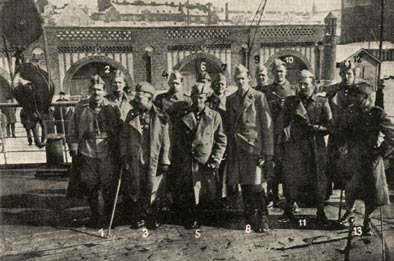
A group of Danish Junior Officers aboard the Icebreaker Väinämöinen
The Officers in this photo are (1) Fændrik Sørensen (203), (2) Dr. Laurent-Christensen – Læge, (3) Løjtnant Poulsen (234), (4) Løjtnant Hassing (206), (5) Kaptajn Borgelin (241), (6) Løjtnant Arildskov (211), (7) Løjtnant Kofoed (202), (8) Kaptajn Gudme (200), (9) Løjtnant Beyer (236), (10) Løjtant Munch-Andersen (232), (11) Kaptajn Mortensen (237), (12) Løjtnant Christensen (238), (13) Løjtnant Larsen (233).
After only a week after arrival the men were moved to the “Africa” barracks, also in Tallinn – which featured significantly better living conditions. The day before the move the corps were issued with Russian guns and could theoretically have been put into service. However, it was found that in the enlistment process, personnel had not been questioned as to prior military knowledge. It was necessary to divide the men into 3 groups according to qualifications and create a regular boot camp for the untrained:
- Those who had undergone military training in Denmark
- Those who had military training from the volunteer corps in Denmark
- Those who had no military training
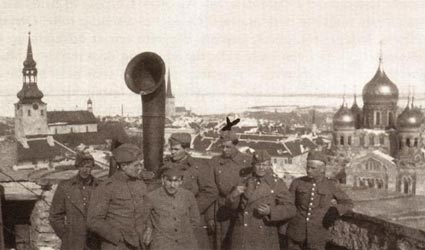
Danish Volunteers sightseeing in Tallinn, 1919
Of the Corps 146 privates, 51 privates were placed in Group C – without any prior military knowledge. In order to quickly remedy the lack of skills before being deployed, Captain Borgelin began an intensive military training period for the Danish squad over the first two weeks of April. Recruit School in the Africa barracks started with daily lessons from 0900-1200 and again from 1500-1800, but this was soon changed to teaching from 0800-1400, so that the rank and file – and also the officers who taught – had a chance to experience the many attractions of the historic capital of Estonia. It was not only historic buildings that were to be examined in Tallinn, other sights were visited and it was found that the nightly attractions could easily interfere with training at Recruit School. Therefore, a crackdown against attending nighttime shows in the neighborhood was carried out – an offense which resulted in 8 Days strict arrest. Another problem was the risk of STDs – which was taken very seriously – with all the rank and file commanded to be present for “Penis Parade” on Sunday 13 April at 9.00am.
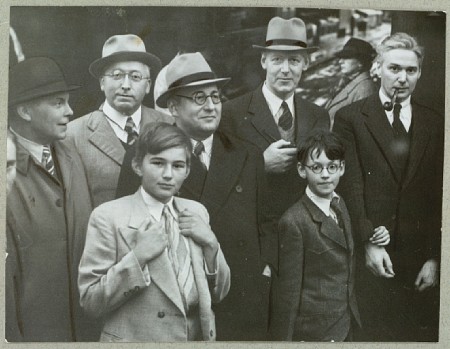
Representatives of the Danish volunteers from Finland’s war of liberation on the way to Helsinki to participate in memorial celebrations – 1939-40 – From left: Lt. Clauson-Kaas, Dr. Larsen, Landsretssagf. Eiler Pontoppidan, Ivar de Hemmer Gudme and National Journal Employee, Moderator Peter de Hemmer Gudme (image from http://www.kb.dk/images/billed/2010/okt/billeder/object136035/da/#)
DBAC’s first weeks in Estonia were in many ways influenced by the uncertainty that existed with regard to the corps future use. The Danish soldiers there were supposedly and initial unit – 1 Rifle Company and a single Field Artillery battery – a strength which in March and early April 1919 was meant to grow to about 1,000 men. As it was, towards the end of April it was clear that there would be no more Danish volunteers – the corps was then renamed Rekylkompagni (Rifle Company) Borgelin with Captain Borgelin as commander and a Train-unit under Captain Mortensen. The Corps Head of the Danish Baltic Auxiliary Corps – Iver de Hemmer Gudme – then took the role as administrator for the Danish Corps in Tallinn and as liaison with the DBAC’s office in Copenhagen, the British naval forces in Estonia and the Estonian War Ministry. The organizational problems were not known among the men – they just had to await orders and listen to the countless rumors swirling around in Tallinn.
However, for those men who already had military training prior to their arrival in Estonia, the time was not wasted, nor was their first week in Tallinn completely ineffectual. On 5th-7th April elections were being held for the Constituent Assembly in Estonia, at a time when the country’s position was very unstable, with threats along the borders in the south and east, with large white Russian forces in the country and an inner turmoil from both the German-Baltic and Zar-faith groups – neither of whom desired an independent Estonian state. Therefore Tallinn was in a state of military alert until parliament opened.
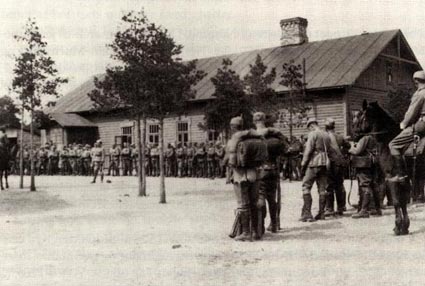
Parade in training camp in Nõmme – May 1919 – image sourced from: http://www.warcovers.dk/estonia/nomme_pic2.jpg
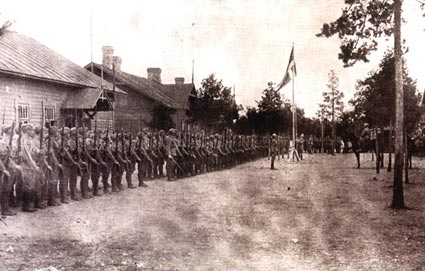
Flag Parade at Nomme training camp, May 1919
The DBAC were invited to provide military patrols to ensure peace and order in the capital. Double patrols of 10 ratings and 1 Corporal – armed and with fixed bayonets – patrolled Tallinn’s streets both day and night in order to allay any unrest. This service as “Palace Guard” for the Estonian government passed without incident and ended when the Estonian Parliament met on 23 April 1919.
On 26 April the entire Danish company marched on foot to the former German training camp at Nõmme, about 10km outside Tallinn. The Estonian army command had wanted the Company to move to the Southern front as soon as possible, but Borgelin asked for 14-day training camp in Nõmme to further train the motley group of volunteers to operate as a unit. The Training Camp at Nõmme consisted of 4 large wooden buildings and was in an ideal environment for the Company’s final training – here was both open heath-land, pine forests and ample space for exercise in advance in “disarray” and “groups advance” – just as there were areas suitable for shooting training and grenade throwing.
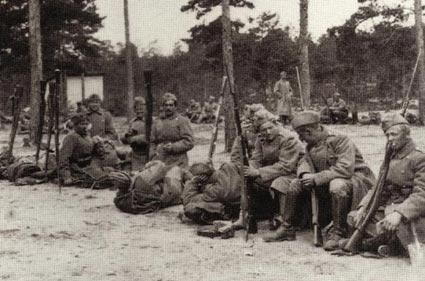
Rest during the exercises in Nõmme camp – May 1919
On 10th May the Company’s seven Madsen-rekylgeværer (machine guns) were delivered – which resulted in the men performing strenuous training on the new weapons. On 17th May the Company was alerted and all were informed that the Company Borgelin was departing for the front on the following day. Before departure all equipment was assembled and packed to be loaded on a special transport train and the camp was cleaned.
On Saturday the 18th May at 1200 the entire company was paraded to share orders and for an inspection by the Estonian army commander, General Laidoner. Laidoner also received demonstration in Danish field service tactics: Patrol Company, Ensuring site security during the march, Sharp Shooting, Hand Grenade Throwing and not least – Combat Shooting with rekylgevær division light machine guns. Captain Borgelin could then announce that the 12 Officers, 12 NCO’s and 189 privates were ready for service. Later in the day the Company marched to Nõmme station and boarded the train.
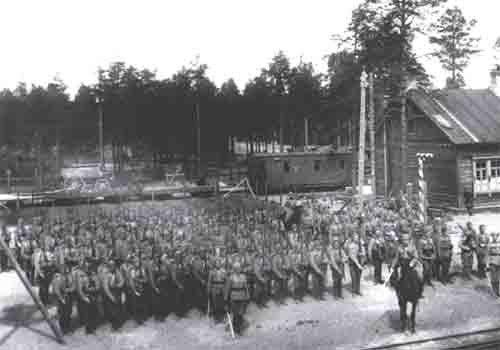
The Danish Volunteers on Parade
They were deployed on the southern front near Wörru in Southern Estonia. Shortly after the Danes arrived at the front, an offensive was initiated by Colonel Puschar through Latvia to Jakabpils (James Stadt) by the Daugave (Duna) river. A joint Estonian-Latvian force drove the Bolsheviks out of Latvia in just 14 days. Latvia would then see an internal battle between the Latvian government forces and the German-Baltic “Landeswehr” in Kurland. This conflict lay outside the Danish Volunteers contract with the Estonian Government. The Corps was pulled into reserve in Laudon (Latvia) and then moved to a rest area in Dorpat (Estonia). After a rest period from 1 to 24 July, the Danish Corps was again ordered to the front. This time to a section of the front between Ostrow and Porchow in the Russian Governorate of Pskow.
In Dorpat, Thursday 24 July, the scheduled departure from the rest area was suddenly advanced by 3 days by the same afternoon the Company had arrived at the railway station, where a crowd of acquaintances among the ladies in Dorpat had come with flowers. As the train jerked into motion a few hours later, the Danes threw their flowers overboard and those who sat on the roof – shot up in the air. They remained on the train over Friday. Everywhere there were the ugly traces of the war. The long bridge over the Pskow River had been blown and only rudimentary repairs with timber beams had been carried out. At 3 o’clock the train arrived at Tschaskaja station and the men, provisions and ammunition wereoffloaded. After a few hours the Company continued on foot south to prudo – a 7 hour night march.Prudo was reached on the following morning just before noon. The city was full of Russians and Estonians who all stood staring at the Danes – the “Shirt Sleeve-Company”.
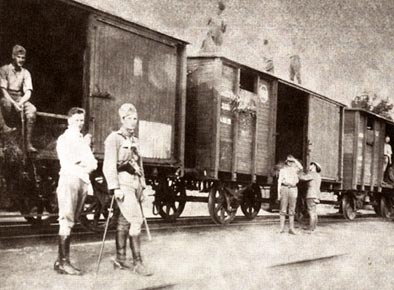
The Danes leaving Dorpat – 24 July 1919
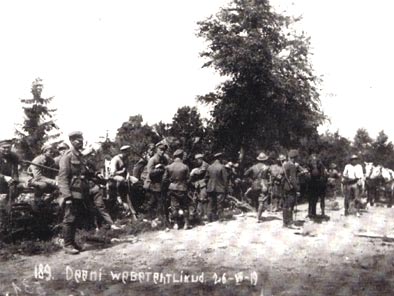
Rest period during the march into the battle zone – 26 July 1919
After a short rest the Company advanced into the battle zone. In the afternoon, two villages were taken, despite heavy resistance from the Reds, without Danish losses. The Estonian brothers in arms – the Eesti Scouts Polk – could not keep up with the advance, so they got field guard duty that night. The Danish Company got off duty and could sleep. The farmers in the Zerkowschina village loved the Danes, so it was easy to get food and find a good place to sleep.
By early Sunday morning, 27 July the Danish Company had captured a windmill near Zerkowschina and at 11 o’clock, two officers (Opffer and Christensen) sent on reconnaissance to the nearest village – Sarmulinov. Everything seemed peaceful, so Opffer and Christensen thought that the Red forces had already left the village. They approached the village along the railroad line and were at a distance of only 20 meters, before they discovered their mistake and had to turn back. The Bolsheviks did not shoot immediately, but tried shouting in German and French to draw the Danes closer, they thought the two Danish officers were Estonian renegades.
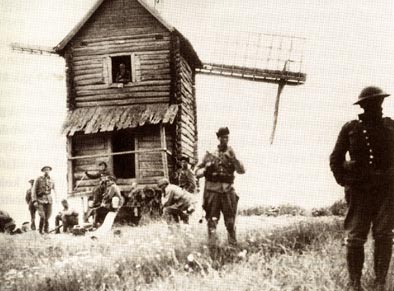
Command Post at the windmill in Zerkowschina – 27 July 1919
The Danes would not respond and tried to retreat. Only then did the Reds shoot. Christensen threw himself down immediately and shot back, but Opffer was hit by a bullet and fell to the groundm shot through the heart. Christensen tried to carry Opffer, but was hit in the arm. He managed to find cover behind the railway embankment and after fierce persecution by the Bolsheviks he managed to return to the Danish position at the mill in Zerkowschina. Later, a strong patrol of 5 men set off for Sarmulinov in a rescue attempt. Corporal Jeppesen with 4 privates was sent out to pick up Opffer (For a conflicting account, see Niels Jensen’s book, where he writes that the patrol was already deployed when Opffer was killed. The Patrol rushed towards Opffer and Christensen to help when they heard the shooting). As the patrol approached the village, they did not see the Bolsheviks. When they were at a distance of about 100 meters, the enemy suddenly moved forward and pounded the Danes from several sides.
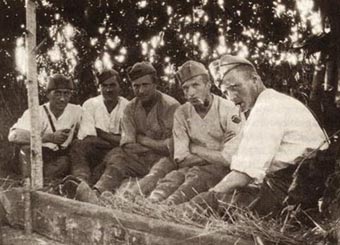
Danish Soldiers resting in Latvia
Kjøller was immediately hit and the 3 other privates fled into a rye field. Corporal Jeppesen shouted: “Not in the rye!” as his men disappeared – but too late. The Red lays hidden in the rye field and two privates, Dyhrberg and Jensen, were overpowered and captured. From company records, the result was close combat near Sarmulinov. Lieutenant Alfred John Poulsen immediately tried to bring men together to help their fellow soldiers. Corporal Jeppesen, the wounded Kjøller and an uninjured soldier managed to escape back to their own front. Opffer’s body was not immediately recovered and the company had suffered further losses.
The entire company was assembled and later in the afternoon the Danes attacked Sarmulinov in full strength, capturing the village without further resistance from the Reds. In the village, a Russian peasant told the Danes that the Reds had been about to execute their prisoners, but had been interrupted by the Danish attack and had retreated with the prisoners. In the village the Danes found traces of one of the missing soldiers. In a nearby rye field was found a waist belt with No. 434 on it. A bullet had entered the rear through a cooking vessel, into the back and passed out the front through the belt and into a cartridge bag. No. 434 was Private Laurits Petersen Dyhrberg from Herning.
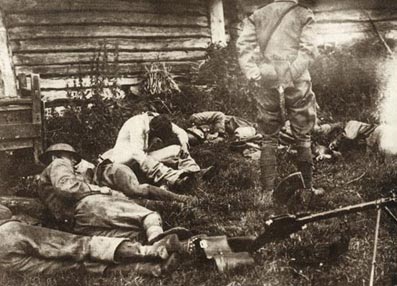
The Danes resting during fighting on the Ostrow Front
With the discovery of the pierced belt in mind, Lieutenant Max Arildskov wrote a letter to Dyhrberg’s parents in Denmark. Apart from conveying the unfortunate message that their son had been captured by the Red’s, the lieutenant also advised that Laurits Dyhrberg had been injured. In the Berlingske Tidende newspaper of 8 August 1919, one could read that editor Frederik Opffer and his wife had lost their young son. – Søren Christian Opffer, who was named after his grandfather who had been a volunteer soldier in the Kirkestatens Fremmedlegion and who had also participated in the Italian war of liberation in 1848.
On 13 August the same newspaper published an official announcement from the Estonian Press Bureau in Copenhagen. This announcement advised that the head of the Danish Corps, Captain Gudme, had advised the names of five volunteers who had fallen and 4 who had been captured during the recent fighting in Ostrow-front. The message may have only referred to the Danish loss from 27 and 28 July. In the following days the Danish corps experienced further losses and a rapidly growing number of soldiers had to be sent to the rear of the front due to illness. Thus, it is stated that on 14 Aug there were approximately 60 men capable of fighting at the front – the rest were fallen, injured or incapacitated due to illness.
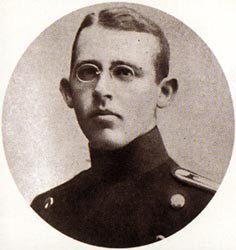
Kornet Søren Christian Opffer
The Estonian Press Bureau’s announcement on 13 August reported that Opffer’s body would be sent back to Denmark. Along with the repatriation of the Danish Corps in early September, the bodies of two fallen comrades – but not Opffer’s – were shipped back to Denmark. In the coming weeks, Opffer repeatedly called and on 30 September 1919 the Estonian Legation in Copenhagen sent an urgent telegram to the War Department in Tallinn: “Why has Opffer’s body had not arrived STOP. Corpse is apparently handed over to the Estonian Red Cross STOP Was seen boarding a train to Dorpat STOP Telegram advised that it would arrive by ship” Baltonia “but did not STOP”. The Estonian steamer S/S “Baltonia” sailed in late August from Baltischport (Paldiski) directly to Copenhagen with a small group of 8 volunteers who should be home by the expiry of their contract on 1 September.
Over a month later – on 10th November 1919 – a clerk at the Estonian Red Cross cemetery office in Wörru announced that: “… to Lieutenant Opffer was buried in the cemetery at Wörru on August 3rd, so it can not be his body that was seen boarding a train in Dorpat. The corpse was however, no longer in Wörru, since, according to instructions from the Estonian Red Cross it had been dug up and sent to Tallinn for further transport to Denmark.” – Here ends the trail and Oppffer’s body was never located. Kornet Søren Christian Opffer was posthumously promoted to Lieutenant and awarded the Estonian Freedom Cross.
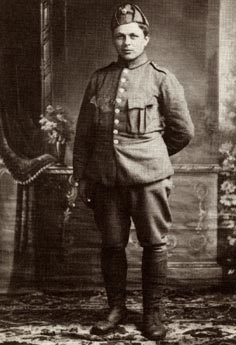
Danish Volunteer Private 434 Laurits Petersen Dyhrberg
On 17 August 1919 the Estonian Press Bureau advised that negotiations were ongoing between the Estonian government and the Bolshevik army leadership regarding the exchange of prisoners of war – exchanges had previously happened, so there was hope that the four Danish prisoners would soon be free, if in the meantime they have not already had succumbed to their wounds. The last sentence was probably aimed at Dyhrbergs fate. In September, an escaped Swedish prisoner reported that all four Danish prisoners were in good health, the two wounded were in a Russian military hospital and the other two were working as train drivers for the Bolsheviks.
The reality however was quite different. After Dyhrberg disappeared into the rye field, he was not injured by gunfire. The perforated waist belt found was one he had loaned to a friend, 418 Jens Christian Jensen, who must have been wounded by the bullet that pierced both kettles, waist belt and cartridge pouch. Dyhrberg was hit on the steel helmet and was knocked unconscious. When he came to, he was lying in a ditch surrounded by enemies, “Now I am going to be shot, I just hope they do it quickly” he thought, but to his surprise, an officer rode up to him and said “Do not be afraid, we are not as bad as they say. you will go to a prison camp and when the war is over, you come home.” The officer was a Pole and had worked in Denmark as beet worker.
After much difficulty, Dyhrberg later arrived in Moscow and was sentenced to death as a criminal prisoner – not as a prisoner of war – since he was a foreign soldier, but when the Bolsheviks abolished the death penalty, his sentence was commuted to five years’ hard labor in Paagrowskaja penal camp in the Urals. In 1920, Dyhrberg was accidentally found by the Danish “Red Cross” Delegate, Eigtved, who ensured that Dyhrberg was transferred to a hospital in Moscow and then in August 1920 released. After a quarantine period in Terijoki in Finland, he once again returned to Denmark.
Efforts on the Ostrow-front cost the Danish Corps dearly, and this was the last fighting that the Danish volunteers participated in, in the Baltics. By the end of August the contract with the Estonian Government had expired and by early in September, the majority of the Danish soldiers were again at home in Denmark. Some remained in Estonia to continue the fight in other volunteer corps – including the Swedish Vita Legion. Borgelin and seven other Danes were awarded the Latvian military Order of Lāčplēsis third class. Borgelin was also promoted to Lieutenant Colonel in the Estonian Army for his services in the War of Independence, and was given the Estonian manor of Maidla in recognition of his services.
Borgelin was awarded the Latvian military Order of Lāčplēsis “Bear Killer”) third class for heroism in an action on the River Dauga, the border between Latvia and Lithuania, at a town called Daugapils. During the struggle to throw the Bolsheviks out, Russian forces on the south side of the river fired on Latvian forces on the north side. The Latvians had an agreement with the Lithuanians that neither side was to cross the river into the others territory. The Latvians thus were not able to remove the Russians from the south bank, and the Lithuanians forces were too far away to assist. Borgelin had the brilliant idea to send the Danish forces over the river, since they were neither Latvian now Lithuanian and had not signed the agreement, and throw the Russians out. Borgelin led his men across, drove the Bolsheviks out, hoisted the Danish flag in the town square, held the city until the Lithuanians came a few days later, whereupon he presented them with the town, then withdrew his men back to the north side of the river.
The following list is of officers, non-commissioned officers and privates in the Danish Baltic Auxiliary Corps based on a list prepared by the Corps Commander Iver Gudme in September 1919. Where additional information has been available, this has been applied in brackets after the name, given birth date and place to the extent that these data are known. The military ranks are those used in the Estonian army – and does not refer necessarily to ranks acquired in the Danish army or in another country’s army or navy.
Abbreviations: DF = Platoon. SF = Section Driver. R-DEL = Rekylgeværdel. HDF = Half Platoon. KMP = Company. KC = Company Commander (-Commander). NK = Deputy Commander. Three-digit numbers are the ordinary seamen and soldiers numbers in the Corps.
Captain Iver de Hemmer Gudme (15/6-1893 Copenhagen).
Head of the Corps. Capt. Richard Gustav Borgelin (10/2-1887 Herning). Company Commander. (See note below 1) Captain Jens Martinus Mortensen (26/5-7.892 Bredballe). The driver of training.
Lieutenant Christian August Beyer (22/11-1894). Deputy Commander for 6/7 1919th
Lieutenant Charles Th. Dornonville de la Cour (12/10-1884 Hinnerup). DF third PART.
Lieutenant Peter Viggo Christensen (29/12-1892 Egebjerg). DF R-DEL. KC 6/7-3/8. NK 3/8.
Lieutenant Eric Munch-Andersen (7 / 11-1892 Vorbasse). DF second PART.
Lieutenant His Oscar Kofoed (8/6-1891 Ronne). HDF R-DEL. DF R-DEL 16/7.
Lieutenant Kaj Valdemar Hassing (15/10-1892 Copenhagen). DF fourth PART. Calipers. Intendant.
Lieutenant Max John Arildskov (17/12-1896 Overgård Havndal). SF RDEL.
Lieutenant Alfred John Poulsen (1/12-1891 Maribo). DF first PART.
Lieutenant Alfred Laurits Larsen (7/5-1894 Hårby). HDF R-DEL.
Lieutenant Peter de Hemmer Gudme (22/9-1897 Copenhagen). SF R-DEL.
Lieutenant Oscar Schilling. To intoxication. Nordvestarmé. The decrease 25/4-1919 by Gatschina.
Doctor Axel Laurent Christensen. For Valdemar ambulance 24/41919.
Physician Walther Lundberg (German-Balter, Estonian citizen) tilkomm. Corps 20/4-1919.
Ensign Vagn Stefani Steffensen (25/10-1896 Copenhagen). From grain 22/6. 18/7 DF third PART.
Ensign Axel Theilmann (22/11-1896 Hvidkilde). From grain 22/6. By trainet.
Ensign Knud V Zeltner (2/11-1897 Vallo). From grain 22/6. DF second PART.
Ensign Otto C. Klingemann (23/6-1896 Fr.havn). From grain 22/6. DF by trainet.
Ensign Ernst Emil Count Holstein (13/4-1901 Copenhagen). Military aide.
Ensign Carl Bear Schutten (3/5-1895). Got 2 weeks of leave 2/6 – failed to materialize after a break.
Ensign Søren Christian Opffer. From grain 22/7. The fall on the same day at Ostrow.
Feltwebel Carl Sorensen. At the corps chief. Absent after a break. Vicefeltw.
Frits Emil Berg (25/6-1896 Fr.berg). Udn. 22/6. At the second PART recent first PART.
Vicefeltw. Erneste Peronard (10/3-1887 Copenhagen). Udn. 27/7. At the fourth PART later third PART.
Vicefeltw. William Thorbjørnsen (17/12-1891). Udn. 15/8.
Vicefeltw. Aage Grønbech tirunnet. Udn. 15/8.
Vicefeltw. H. Harlev Varlev. Udn. 15/8.
Vicefeltw. H. Læssøe Arboe. Udn. 15/8.
Sergeant Peter Romanus Jensen.
Sergeant Axel Edmund Karl Jensen (6/8-1894 Copenhagen).
Sergeant Ivar Fredrich Jensen (5/6-1895 Løndt Schleswig).
Sergeant Soren Christian Teping (26/1-1895 Copenhagen ).
Sergeant William Emil Larsen. Absent for sickness.
Sergeant Thorvald Emil Johan Bull. Waiting in Copenhagen.
Sergeant Knoblauch. Udn. 15/8.
Sergeant Gleerup. Udn. 15/8.
Sergeant Hansen. Udn. 15/8.
Sergeant Sorensen. Udn. 15/8.
Sergeant George Christian Jeppesen (3/12-1885 Valby Copenhagen). grain
Knud Erik Christensen (21 / 3-1897 Mariager). Deserted.
Cornet August Helmund (17/3-1895 Mariager).
Corporal Christian Peter Christensen. 209th
Corporal HP Theodor Lauritzen (29/2-1888 Gjellerup).
433rd Corporal Hans Jens Jensen (28/7-1874 Bakkebølle Vordingborg).
409th Corporal Christian Altenkrone (13/6-1897 Raarup).
240th Corporal Jens Eskild Ley Christie (2/8-1894 Copenhagen).
225th Corporal Hans Jorgensen (7/6-1894 Seestrup).
2? 2nd Corporal Christian H. Rasmussen (2/7-1887 Aarhus).
389th Corporal Hans Waldemar Johansen.
429th Corporal Martin Sofus Arildskov (24/6-1866 Ristrup).
444th “Old Arildskov.” Corporal Eugene Octavius Schultz (24/3-18 84 Copenhagen).
317th Corporal Viggo Jorgensen (Copenhagen 25/6-1892).
229th Corporal C. Petersen.
216th Home Sent. Corporal Tillo Nielsen.
27th Absented. Corporal Lauge.
443rd Kitchen. Corporal Christian Rasmussen.
223rd Absent. Corporal Kai Konrad Hauge (7/4-1899 Elsinore).
303rd Corporal Jens Christian Olsen (30/7-1891 Copenhagen).
366th Corporal Ove Einar Petersen (23/2-1895 Nørresundby).
373rd Corporal Svend Sarder (24/4-1890 Aarhus).
406th Corporal Henry Christian Jensen (20/3-1899 Udbyovre Mark).
Corporal Verner Felix Frederiksen (16/12-1900 Copenhagen).
423rd Corporal Frantz H. Leudersdorff (30/3-1900 Copenhagen).
459th Corporal Christian Jensen (21 / 10-1896 Randers).
450th Corporal JCF Larsen (20/1-1899 Aarhus).
402nd Corporal Arthur Leonard Alsvold (20/12-1899 Nykøbing).
438th Corporal Bertel Hansen (27/8-1892 Nakskov).
425th Corporal Christian Schultz (1 / 9-1888 Almind v. Vejle).
412th Corporal Hilbert Christiansen (7/6-1888 Copenhagen).
333rd Corporal August Bruus (3/11-1887 Odense).
359th Corporal Henry Eduard Bardrum (21 / 11-1896 Copenhagen).
393rd Corporal Mahnfeldt.
456th Corporal Gustav Emil Gabrielsen (15/12-1892).
446th Corporal John Smith (1 / 1-1898).
428th Corporal George Kjøller (31/7-1876 Bugelskær parish Nexo).
449th Corporal Niels Prühl Nielsen (30/10-1897 Ringkøbing).
430th Corporal John Eskild Ley Christie (2/8-1894 Copenhagen).
440th Corporal John Marius Madsen (8/2-1895 Søby).
441st Corporal Saul Nielsen (25/7-1895 Copenhagen).
458th Corporal AAK Hansen (23/7-1898 Svendborg). 342nd
Ordinary seaman 300 Petersen.
Ordinary seaman 301 Larsen. Home Sent.
Ordinary seaman 302 Jørgensen. Not met.
Ordinary seaman 303 Hauge. Udn. to Corporal 15/8.
Ordinary seaman 304 Moller. Not met.
Ordinary seaman 305 Niels Christian Petersen.
Ordinary seaman 306 Rasmussen.
Ordinary seaman 307 Lund. Not met.
Ordinary seaman 308 Johansen. Not met.
Ordinary seaman 309 Hansen.
Ordinary seaman 310 Andersen.
Ordinary seaman 311 Thomsen.
Ordinary seaman 312 M. Andersen.
Ordinary seaman 313 Berg.
Ordinary seaman 314 Christiansen.
Ordinary seaman 315 Hansen.
Ordinary seaman 316 Christensen.
Ordinary seaman 317 Schultz. Udn. to Corporal 15/8
Ordinary seaman 318 Andersen. Kitchen.
Ordinary seaman 319 Jensen.
Ordinary seaman 320 Mohr.
Ordinary seaman 321 Harold Charles Andersen, Copenhagen. The decrease in Ostrow.
Ordinary seaman 322 Fritz Madsen. In prison. 5 years’ fortress arrest in Estonian prison camp, Pääskylä.
Ordinary seaman 323 Petersen.
Ordinary seaman 324 Varlev. Udn. to vicefeltwebel 15/8
Ordinary seaman 325 Christian Breyer. Death of black cups in All Schwaneburg.
Ordinary seaman 326 Hansen. Home Posted due to illness (appendicitis).
Ordinary seaman 327 Petersen.
Ordinary seaman 328 Ejnar Eli Olsen (2/1-1896).
Ordinary seaman 329 Petersen. Udn. to Corporal – demoted to private.
Ordinary seaman 330 Hansen.
Ordinary seaman 331 Neist.
Ordinary seaman 332 Holmgaard.
Ordinary seaman 333 Christiansen. Udn. to Corporal 15/8.
Ordinary seaman 334 Jensen.
Ordinary seaman 335 Hansen. Sick Fits.
Ordinary seaman 336 Bernhard.
Ordinary seaman 337 Hansen.
Ordinary seaman 338 Ludvigsen.
Ordinary seaman 339 Nielsen.
Ordinary seaman 340 Nielsen. Home Sent.
Ordinary seaman 341 Hansen.
Ordinary seaman 342 Hansen. Udn. to Corporal 15/8.
Ordinary seaman 343 Petersen.
Ordinary seaman 344 Nielsen.
Ordinary seaman 345 Svendsen. Not met.
Ordinary seaman 346 Rasmussen.
Ordinary seaman 347 Jensen.
Ordinary seaman 348 Petersen.
Ordinary seaman 349 Louis Hansen. The decrease in Hanja 28/5.
Ordinary seaman 350 Larsen. Ordinary seaman 351 Nis Christian Geert (15/10-1895).
Ordinary seaman 352 Mortensen. The wound itself by hand.
Ordinary seaman 353 Larsen.
Ordinary seaman 354 Grimm. Home Sent.
Ordinary seaman 355 Larsen.
Ordinary seaman 356 Jørgensen.
Ordinary seaman 357 Alfred Rasmussen, Copenhagen. Taken prisoner by the Bolsheviks.
Ordinary seaman 358 Alex H. Hansen. Fallen.
Ordinary seaman 359 Bruun. Udn. to Corporal 15/8.
Ordinary seaman 360 Jørgensen. Home Sent.
Ordinary seaman 361 Name unknown. Not met.
Ordinary seaman 362 Holm.
Ordinary seaman 363 Aage Valdemar Jensen (23/12-1896).
Ordinary seaman 364 Hansen.
Ordinary seaman 365 Hansen. O
rdinary seaman 366 Olsen. Udn. to Corporal 15/8.
Ordinary seaman 367 Jørgensen.
Ordinary seaman 368 Nielsen.
Ordinary seaman 369 Larsen.
Ordinary seaman 370 Larsen. Saddler.
Ordinary seaman 371 Sorensen.
Ordinary seaman 372 Christensen.
Ordinary seaman 373 Petersen. Udn. to Corporal 15/8.
Ordinary seaman 374 Larsen.
Ordinary seaman 375 Olsen. Not met.
Ordinary seaman 376 Rosenkilde.
Ordinary seaman 377 Rosenkilde.
Ordinary seaman 378 Moen.
Ordinary seaman 379 Name unknown.
Ordinary seaman 380 Melberg. Not met.
Ordinary seaman 381 Hans Christian Jensen. Died of wounds.
Ordinary seaman 382 Poul Nielsen (8/7-1900).
Ordinary seaman 383 Petersen. Not met.
Ordinary seaman 384 Wiggers. Home Sent.
Ordinary seaman 385 Quist.
Ordinary seaman 386 Charles Alfred Krause, Copenhagen. The decrease in Ostrow.
Ordinary seaman 387 Andersen.
Ordinary seaman 388 Andersen.
Ordinary seaman 389 Rasmussen. Udn. to Corporal.
Ordinary seaman 390 Christiansen. Not met.
Ordinary seaman 391 Petersen.
Ordinary seaman 392 Nielsen.
Ordinary seaman 393 Bardrum. Udn., To Corporal 15/8.
Ordinary seaman 394 Madsen.
Ordinary seaman 395 Sigfrid Edm. Th. Hansen (25/10-1895).
Ordinary seaman 396 Jensen.
Ordinary seaman 397 Myller. Absented.
Ordinary seaman 398 Svend Hartig.
Ordinary seaman 399 Petersen.
Ordinary seaman 400 Henry Emanuel Poulsen (24/6-1900).
Ordinary seaman 401 Arboe. Udn. to vicefeltwebel 15/8.
Ordinary seaman 402 Larsen. Udn. to Corporal 15/8.
Ordinary seaman 403 Christoffersen.
Ordinary seaman 404 Hilmar Teklar Nielsen (11/7-1890).
Ordinary seaman 405 Petersen. Tailor.
Ordinary seaman 406 Sarder. Udn. to Corporal 15/8. Ordinary seaman 407 Larsen. Trained.
Ordinary seaman 408 Henriksen.
Ordinary seaman 409 Jensen. Sick Fits.
Ordinary seaman 410 Jensen.
Ordinary seaman 411 Nielsen.
Ordinary seaman 412 Schultz. Udn. to Corporal 15/8.
Ordinary seaman 413 Name unknown. Not met.
Ordinary seaman 414 Brahe.
Ordinary seaman 415 Andersen.
Ordinary seaman 416 Godtfred Rich. Jørgensen (6/3-1898).
Ordinary seaman 417 Lyng Power.
Ordinary seaman 418 Jens Christian Jensen, Copenhagen. The wound. Taken prisoner by the Bolsheviks.
Ordinary seaman 419 Rasmussen.
Ordinary seaman 420 Jeppesen. Udn. to Sergeant 15/8. Ordinary seaman 421 Jensen. Home Sent.
Ordinary seaman 422 Rosenstand.
Ordinary seaman 423 Frederiksen. Udn. to Corporal 15/8.
Ordinary seaman 424 Hans Christian Larsen, Copenhagen. The decrease in Ostrow.
Ordinary seaman 425 Hansen. Udn. to Corporal 15/8.
Ordinary seaman 426 Viggo Hansen (Hejninge). Udn. to Corporal 15/8. Later, Sergeant?
Ordinary seaman 427 Clausen.
Ordinary seaman 428 Hansen. Udn. to Corporal 15/8.
Ordinary seaman 429 Johansen. Udn. to Corporal 15/8. Ordinary seaman 430 Nielsen. Udn. to Corporal 15/8.
Ordinary seaman 431 CCLF Scavenius (14/7-1899).
Ordinary seaman 432 Lindberg.
Ordinary seaman 433 Lauritzen. Udn. to Corporal.
Ordinary seaman 434 Laurids Petersen Dyrberg (14/12-1897 in Boarding). Wounded and captured by the Bolsheviks in Ostrow.
Ordinary seaman 435 Madsen.
Ordinary seaman 436 Hansen.
Ordinary seaman 437 Jensen. Ordinary seaman 438 Alsvold. Udn. to Corporal 15/8.
Ordinary seaman 439 Jensen. Udn. to Corporal 15/8.
Ordinary seaman 440 Bruun. Udn. to Corporal 15/8.
Ordinary seaman 441 Madsen. Udn. to Corporal 15/8.
Ordinary seaman 442 Petersen. Ordinary seaman 443 Lauge. Udn. to Corporal 15/8.
Ordinary seaman 444 Arildskov. Udn. to Corporal 15/8. Ordinary seaman 445 Petersen.
Ordinary seaman 446 Gabrielsen. Udn. to Corporal 15/8.
Ordinary seaman 447 Hoegh Petersen.
Ordinary seaman 448 Samuelsen.
Ordinary seaman 449 Kjøller. Udn. to Corporal 15/8.
Ordinary seaman 450 Jensen. Udn. to Corporal 15/8.
Ordinary seaman 451 Holstein. Udn. to ensign.
Ordinary seaman 452 Lerbech. Deserted. Ordinary seaman 453 John Sorensen, Aarhus. Caught by the Bolsheviks in Ostrow.
Ordinary seaman 454 Jensen.
Ordinary seaman 455 Eyolf SiMn Petersen (31/12-1899).
Ordinary seaman 456 Mahnfeldt. Udn. to Corporal 15/8.
Ordinary seaman 457 Frederiksen.
Ordinary seaman 458 Nielsen. Udn. to Corporal 15/8.
Ordinary seaman 459 Leudesdorff. Udn. to Corporal 15/8.
Ordinary seaman 461 Andersen.
Ordinary seaman 462 Fabricius.
Siamese Major. (God knows what a Siamese Army Major was doing fighting against the Bolsheviks in Estonia and Latvia in 1919 – there has to be a story in this somewhere!)
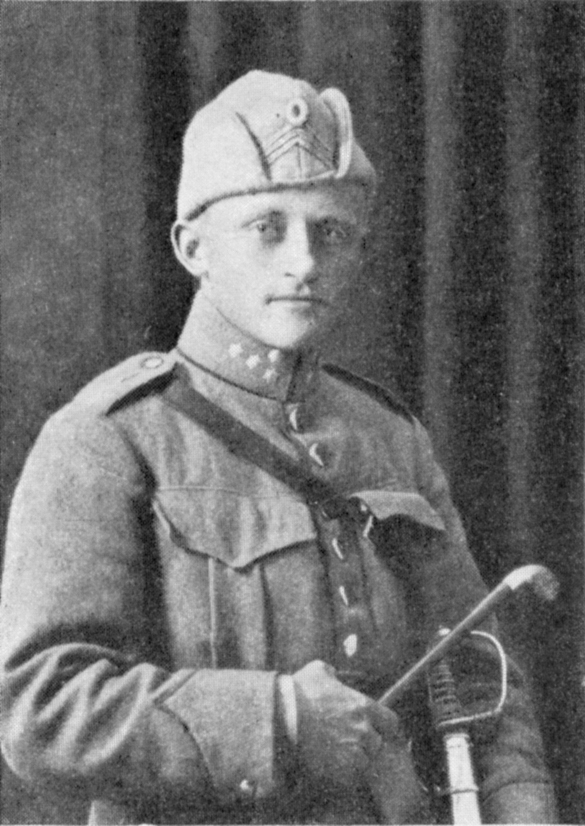
Captain Richard Gustav Borgelin
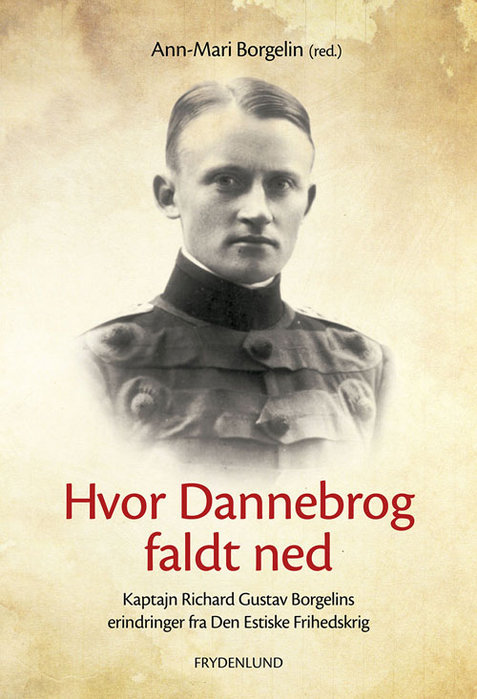
HVOR DANNEBROG FALDT NED AF R. G. BORGELIN by Boregelin’s daughter
HVOR DANNEBROG FALDT NED AF R. G. BORGELIN
The Publisher writes: A gripping tale of a forgotten part of Danish history, and a unique memoir – the first published comprehensive history in Danish – where Danish Captain Borgelin tells of his experiences during the Estonian War of Independence almost 100 years ago. In 1919, a small company set out from Denmark to the Baltic States to help the Estonians in their struggle for freedom from Russia and the feared Bolsheviks. There was no consensus among the Danish rulers to send help to Estonians, but the Company set off regardless – under the leadership of Captain Richard Gustav Borgelin.
This immersive and captivating report compiled by Borgelins daughter Ann-Mari, and based on her fathers memoirs, talks about everything from daily life among the soldiers to the friendly local people affected by the horrors of war and of the Bolsheviks cruelty. The book draws Company Borgelin out of oblivion and MP and former Minister Bertel Haarder says in his foreword: “Denmark does not have many heroes in its military history. Captain Borgelin is one of the few. A country retain the memory of its heroes. Therefore, this book is important. ”
Orientation to the reader: Some pages from Captain Borgelins original manuscript have been unfortunately lost. This is indicated in italics in the book.
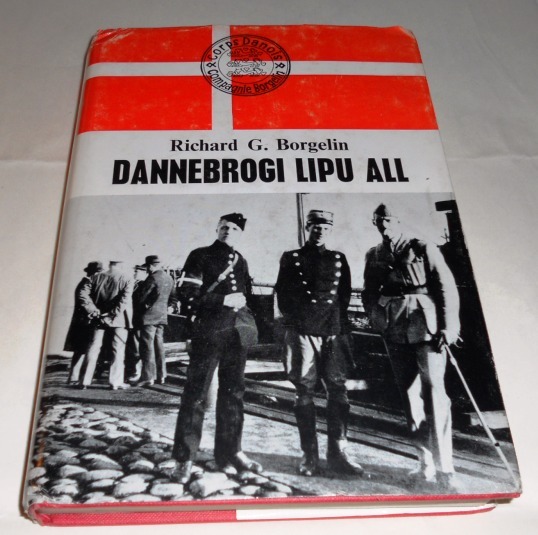
The book published in Estonian
Acknowledgements: The above was in large part sourced from http://www.warcovers.dk/estonia/dbac.htm and translated from the Danish.
 Copyright secured by Digiprove © 2013 Alternative Finland
Copyright secured by Digiprove © 2013 Alternative Finland


2 Responses to Danish Volunteers in Estonia and the Estonian War of Independence